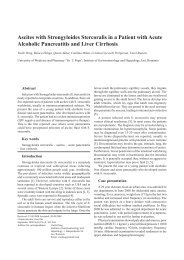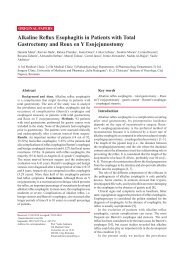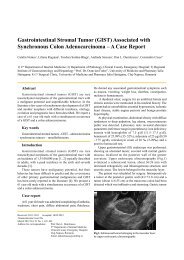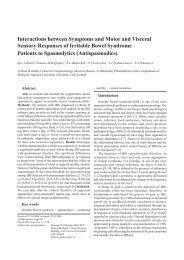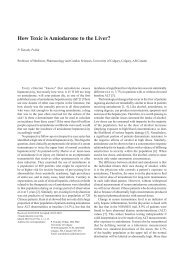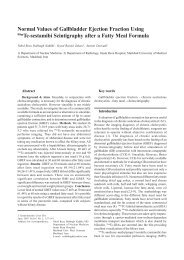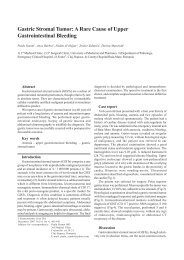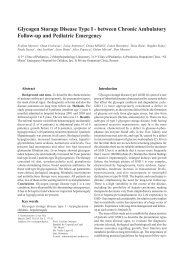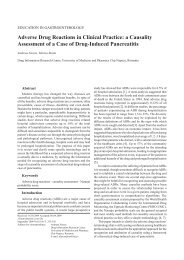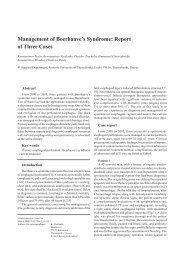Amiodarone Induced Liver Cirrhosis. Report of two cases
Amiodarone Induced Liver Cirrhosis. Report of two cases
Amiodarone Induced Liver Cirrhosis. Report of two cases
You also want an ePaper? Increase the reach of your titles
YUMPU automatically turns print PDFs into web optimized ePapers that Google loves.
CASE SERIES<br />
<strong>Amiodarone</strong> <strong>Induced</strong> <strong>Liver</strong> <strong>Cirrhosis</strong>. <strong>Report</strong> <strong>of</strong> <strong>two</strong> <strong>cases</strong><br />
Muslim Atiq, Jeremy C. Davis, Laura W Lamps, Susan S. Beland, James E. Rose<br />
Division <strong>of</strong> Gastroenterology and General Medicine, Department <strong>of</strong> Internal Medicine and Department <strong>of</strong> Pathology<br />
University <strong>of</strong> Arkansas for Medical Sciences, USA<br />
Abstract<br />
<strong>Amiodarone</strong> is used commonly in patients with cardiac<br />
diseases. Common side effects include thyroid dysfunction<br />
and hepatic abnormalities. However, recently there has<br />
been concern for developing liver cirrhosis secondary to<br />
amiodarone therapy. We present <strong>two</strong> <strong>cases</strong> <strong>of</strong> liver cirrhosis<br />
in patients taking amiodarone. Their clinical presentation as<br />
well as histological features are discussed in detail.<br />
Introduction<br />
<strong>Amiodarone</strong> is commonly used to treat cardiac<br />
tachyarrhythmias in elderly patients. Many patients receive<br />
this therapy for a prolonged period <strong>of</strong> time. Asymptomatic<br />
elevation <strong>of</strong> serum aminotransferases occurs in 25% <strong>of</strong> those<br />
treated while symptomatic hepatic dysfunction occurs in less<br />
than 1% [1]. <strong>Cirrhosis</strong>, however, is a rare complication <strong>of</strong><br />
chronic oral amiodarone therapy [2]. The cause <strong>of</strong> amiodarone<br />
induced hepatic injury is not entirely clear. Immunologic<br />
mechanisms are suspected in instances <strong>of</strong> acute hepatitis<br />
associated with a positive direct Coombs test [3]. Chronic<br />
liver injury resulting from the long half-life <strong>of</strong> amiodarone<br />
may result in lesions <strong>of</strong> varying nature, including steatosis<br />
that resembles alcoholic liver disease, or phospholipidosis<br />
[4-6]. We report the clinical and histologic features <strong>of</strong> <strong>two</strong><br />
patients with amiodarone induced liver cirrhosis.<br />
reportedly well controlled. He had no history <strong>of</strong> alcohol<br />
intake. Pertinent medications included amiodarone at 200<br />
mg per day, simvastatin and glipizide. He had been taking<br />
simvastatin for several years. However the amiodarone<br />
had been started three years ago. Initial laboratory tests<br />
were as follows: bilirubin 1.9 mg/dL, aspartate amino<br />
transaminase 106 IU/L, alanine amino transaminase 75<br />
IU/L, alkaline phosphatase 147 IU/L, prothrombin time <strong>of</strong><br />
20 seconds. An ultrasound <strong>of</strong> the liver with Doppler showed<br />
a nodular contour consistent with cirrhosis, splenomegaly<br />
and massive ascites. Serologic studies were negative<br />
for chronic viral hepatitis. There was also no clinical or<br />
laboratory evidence <strong>of</strong> autoimmune hepatitis, Wilson’s<br />
disease, or hemochromatosis. A liver biopsy was performed,<br />
which showed steatohepatitis with a striking amount <strong>of</strong><br />
Mallory hyaline within the hepatocytes, and an associated<br />
neutrophilic infiltrate, consistent with amiodarone toxicity<br />
(Fig. 1). The patient died during his hospitalization secondary<br />
to complications from his liver disease.<br />
Case 2<br />
The second patient was a 67-year-old African-American<br />
woman with a history <strong>of</strong> coronary artery disease, congestive<br />
heart failure requiring AICD placement, who was transferred<br />
from an outside facility for increasing confusion. There<br />
Case presentation<br />
Case 1<br />
A 72 year old Caucasian gentleman with diabetes,<br />
hypertension, and chronic kidney disease was admitted with<br />
generalized fatigue and worsening ascites. His diabetes was<br />
Received: 13.08.2008 Accepted: 20.09.2008<br />
J Gastrointestin <strong>Liver</strong> Dis<br />
June 2009 Vol.18 No 2, 233-235<br />
Address for correspondence:<br />
James E. Rose, MD<br />
Division <strong>of</strong> Gastroenterology,<br />
4301-W. Markham St, ML#567<br />
Little Rock, AR-72205, USA<br />
Email: jerose@uams.edu<br />
Fig 1. Low power view <strong>of</strong> liver biopsy with<br />
amiodarone toxicity; note patchy steatosis and<br />
neutrophilic infiltrate. H&E; original magnification<br />
x100.
234 Atiq et al<br />
was no history <strong>of</strong> alcohol use. Review <strong>of</strong> her medications<br />
revealed she was on low dose amiodarone which she had<br />
been taking for 2 years around the time <strong>of</strong> AICD placement.<br />
On examination, her vital signs were stable. Examiantion<br />
revealed asterixis, mild right upper quadrant tenderness<br />
and trace ascites. Her initial work up at the outside hospital<br />
revealed serum aspartate amino transaminase 377 IU/L,<br />
alanine amino transaminase 277 IU/L, alkaline phosphatase<br />
551IU/L, prothrombin time <strong>of</strong> 12.7 seconds. Serologic studies<br />
were negative for chronic viral hepatitis, and there was no<br />
clinical or laboratory evidence for autoimmune hepatitis,<br />
Wilson’s disease, or hemochromatosis. Ultrasound <strong>of</strong> the<br />
liver with Doppler showed homogeneous liver parenchyma<br />
and mild ascites. Sections <strong>of</strong> liver biopsy showed a<br />
marked neutrophilic infiltrate with associated degenerating<br />
hepatocytes and a remarkable amount <strong>of</strong> Mallory hyaline<br />
with well developed pericellular fibrosis and bridging fibrosis<br />
with evidence <strong>of</strong> early cirrhosis, consistent with amiodarone<br />
toxicity (Fig. 2). The patient developed cardiopulmonary<br />
failure during her hospital stay and subsequently died.<br />
Discussion<br />
Fig 2. Medium-power view <strong>of</strong> amiodarone toxicity<br />
showing hepatocytes with Mallory hyaline surrounded<br />
by neutrophils. H&E; original magnification x200.<br />
<strong>Amiodarone</strong> is lipophilic and thus accumulates in lipidladen<br />
organs such as the liver. This accumulation in the<br />
lysosomes <strong>of</strong> hepatocytes, as well as bile duct epithelium<br />
and Kupffer cells leads to a build up <strong>of</strong> phospholipids which<br />
produces a phospholipidosis on the basis <strong>of</strong> inhibiting<br />
phospholipase A1 and A2 [7, 8]. Whether phospholipidosis<br />
causes hepatocellular injury is uncertain as liver disease<br />
occurs in only 1% to 3% <strong>of</strong> recipients <strong>of</strong> amiodarone, while<br />
a much larger percentage <strong>of</strong> patients treated with amiodarone<br />
develop phospholipidosis. Therefore, liver injury might<br />
occur separate from or in conjunction with phospholipidosis,<br />
explaining why cirrhosis rarely occurs in patients treated<br />
with amiodarone [1, 2, 6, 9].<br />
Due to its amphophilic nature, amiodarone and its principal<br />
metabolite, N-desethylamiodarone, have been detected in<br />
serum months after stopping the drug [1, 5]. Because the<br />
drug is released slowly from deposits in lysosomes, hepatic<br />
abnormalities may persist for one year even after the drug is<br />
discontinued [1]. Continued liver damage during treatment<br />
with amiodarone may also be secondary to the fact that<br />
amiodarone causes hepatic dysfunction initially and further<br />
limits the hepatic metabolism, thus further increasing the<br />
serum concentration [10]. Consequently, some investigators<br />
have speculated that the total cumulative dose might be<br />
more important in estimating the risk <strong>of</strong> irreversible liver<br />
injury [11].<br />
It is well known that steatosis and non-alcoholic<br />
steatohepatitis (NASH) can be induced by several drugs,<br />
including tamoxifen and anti-retroviral agents [12]. These<br />
drugs inhibit the mitochondrial β-oxidation <strong>of</strong> fatty acids<br />
and respiration, with resultant decrease in ATP and increased<br />
mitochondrial formation <strong>of</strong> reactive oxygen species. These<br />
reactive oxygen species along with lipid peroxidation<br />
products may cause mitochondrial dysfunction which can<br />
also lead to apoptosis and necrosis, thus activating a cascade<br />
leading to fibrosis [13]. Also, many patients receiving<br />
amiodarone have underlying diabetes and hyperlipidemia<br />
such as our first case and a background <strong>of</strong> non alcoholic<br />
fatty liver disease cannot be ruled out; however, rapid<br />
deterioration after instituting amiodarone certainly renders<br />
amiodarone usage the most likely causative agent <strong>of</strong> rapid<br />
liver decompensation secondary to cirrhosis. Also, the<br />
biopsies were not very suggestive <strong>of</strong> steatohepatitis and<br />
in fact showed Mallory hyaline which is very typical <strong>of</strong><br />
amiodarone toxicity.<br />
To date, a total 8 <strong>cases</strong> <strong>of</strong> amiodarone induced cirrhosis<br />
have been reported in the literature [2, 4, 6, 14-19]. As<br />
evident from our <strong>cases</strong>, the range <strong>of</strong> amiodarone usage for<br />
these <strong>two</strong> <strong>cases</strong> was between 2 and 3 years. Our inability<br />
to accurately assess when the first effects <strong>of</strong> amiodarone<br />
induced hepatotoxicity occurred, makes a pharmacokinetic<br />
explanation alone less prudent. A clinical association with<br />
initiation <strong>of</strong> therapy as well as histological features suggestive<br />
<strong>of</strong> amiodarone toxicity strengthens the possibility <strong>of</strong> a causal<br />
relationship. Hence, these <strong>cases</strong> illustrate the importance <strong>of</strong><br />
checking baseline liver associated enzymes in patients who<br />
are being considered for amiodarone therapy, as well as<br />
monitoring them closely during therapy even with low dose<br />
amiodarone. Also, strict alcohol cessation must be ensured<br />
before the beginning <strong>of</strong> therapy due to amiodarone effects<br />
in causing a pseudo-alcohol like syndrome. It is unclear in<br />
the light <strong>of</strong> present data if amiodarone induced cirrhosis may<br />
occur without any abnormalities in liver associated enzymes.<br />
It has been suggested that concentrations <strong>of</strong> amiodarone<br />
below a threshold <strong>of</strong> 1.5 mg/L are associated with a minimal<br />
risk <strong>of</strong> hepatotoxicity, whereas concentrations greater than<br />
2.5 mg/L are associated with a greater than 6% risk <strong>of</strong><br />
hepatotoxicity. There is significant discordance between<br />
changes in amiodarone concentration and the resulting<br />
change in ALT. This model suggests that monitoring ALT<br />
at baseline, 1, 3, and 6 months, and then semiannually<br />
would be an efficient strategy to detect amiodarone-induced<br />
hepatotoxicity [20]. Therefore, it would be premature to<br />
make suggestions about the necessity <strong>of</strong> routine imaging or<br />
biopsy in these patients.
<strong>Amiodarone</strong> induced liver cirrhosis 235<br />
Conclusion<br />
Patients with amiodarone-induced hepatic dysfunction<br />
may have decompensated liver cirrhosis at first presentation.<br />
It shall be considered as a differential diagnosis in patients<br />
with new onset cirrhosis without any obvious cause. Regular<br />
monitoring <strong>of</strong> liver function tests and low threshold for a<br />
liver biopsy to document liver cirrhosis may be considered<br />
early in course <strong>of</strong> disease.<br />
References<br />
1. Lewis JH, Ranard RC, Caruso A, et al. <strong>Amiodarone</strong> hepatotoxicity:<br />
prevalence and clinicopathologic correlations among 104 patients.<br />
Hepatology 1989; 9: 679–685.<br />
2. Puli SR, Fraley MA, Puli V, Kuperman AB, Alpert MA. Hepatic<br />
cirrhosis caused by low-dose oral amiodarone therapy. Am J Med<br />
Sci 2005; 330: 257-261.<br />
3. Breuer HW, Bossek W, Haferland C, Schmidt M, Neumann H,<br />
Gruszka J. <strong>Amiodarone</strong>-induced severe hepatitis mediated by<br />
immunological mechanisms. Int J Clin Pharmacol Ther 1998; 36:<br />
350–352.<br />
4. Singhal A, Ghosh P, Khan SA. Low dose amiodarone causing pseudoalcoholic<br />
cirrhosis. Age Ageing 2003; 32: 224–225.<br />
5. Simon JB, Manley PN, Brien JF, Armstrong PW. <strong>Amiodarone</strong><br />
hepatotoxicity simulating alcoholic liver disease. N Engl J Med<br />
1984; 311: 167–172.<br />
6. Guigui B, Perrot S, Berry JP, et al. <strong>Amiodarone</strong>-induced hepatic<br />
phospholipidosis: a morphological alteration independent <strong>of</strong><br />
pseudoalcoholic liver disease. Hepatology 1988; 8: 1063–1068.<br />
7. Itostetler K, Reasor M, Frazee BW. Mechanisms <strong>of</strong> amiodarone<br />
toxicity: inhibition <strong>of</strong> phospholipase A. Circulation 1984;79 (Suppl<br />
II):240.<br />
8. Heath MF, Costa-Jussa FR, Jacobs JM, et al. The induction <strong>of</strong><br />
pulmonary phospholipidosis and the inhibition <strong>of</strong> lysosomal<br />
phospholipases by amiodarone. Br J Exp Pathol 1985;66:391-7.<br />
9. Lewis JH, Mullick F, Ishak KG, et al. Histopathologic analysis <strong>of</strong><br />
suspected amiodarone hepatotoxicity. Hum Pathol 1990; 21: 59-<br />
67.<br />
10. Letteron P, Sutton A, Mansouri A, Fromenty B, Pessayre D. Inhibition<br />
<strong>of</strong> microsomal triglyceride transfer protein: another mechanism for<br />
drug-induced steatosis in mice. Hepatology 2003; 38: 133-140<br />
11. Klotz U. Antiarrhythmics: elimination and dosage considerations in<br />
hepatic impairment. Clin Pharmacokinet 2007; 46: 985-996.<br />
12. Fromenty B, Robin MA, Igoudjil A, Mansouri A, Pessayre D. The<br />
ins and outs <strong>of</strong> mitochondrial dysfunction in NASH. Diabetes Metab<br />
2004; 30: 121-138<br />
13. Fromenty B, Fisch C, Labbe G, et al. <strong>Amiodarone</strong> inhibits<br />
the mitochondrial beta-oxidation <strong>of</strong> fatty acids and produces<br />
microvesicular steatosis <strong>of</strong> the liver in mice. J Pharmacol ExpTher<br />
1990; 255: 1371-1376<br />
14. Çoban S, Köklü S, Sencer H, Ekiz F, Ormeci N. Low dose<br />
amiodarone associated cirrhosis. J Gastroenterol Hepatol 2007; 22:<br />
140–141.<br />
15. Oikawa H, Maesawa C, Sato R, et al. <strong>Liver</strong> cirrhosis induced by longterm<br />
administration <strong>of</strong> a daily low dose <strong>of</strong> amiodarone: a case report.<br />
World J Gastroenterol 2005; 11: 5394-5397.<br />
16. Jeyamalar R, Pathmanathan R, Wong D, Kannan P. Hepatotoxicity<br />
<strong>of</strong> amiodarone. Ann Acad Med Singapore 1992; 21: 838-840.<br />
17. Tordjman K, Katz I, Bursztyn M, Rosenthal T. <strong>Amiodarone</strong> and the<br />
liver. Ann Intern Med 1985; 102: 411-412.<br />
18. Rinder HM, Love JC, Wexler R. <strong>Amiodarone</strong> hepatotoxicity. N Engl<br />
J Med 1986; 314: 318-319.<br />
19. Flaharty KK, Chase SL, Yaghsezian HM, Rubin R. Hepatotoxicity<br />
associated with amiodarone therapy. Pharmacotherapy 1989; 9: 39-<br />
44.<br />
20. Pollak PT, Shafer SL. Use <strong>of</strong> population modeling to define rational<br />
monitoring <strong>of</strong> amiodarone hepatic effects. Clin Pharmacol Ther 2004;<br />
75: 342-351.




